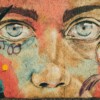Sometime in your life, you have been a scapegoat.
At some point in your life, you have been at the bottom of a pecking order, or at least very near to it, and you have felt ashamed and afraid. It’s likely that this experience morally compromised you. Maybe you lied to protect yourself. Maybe you deflected attention to someone “worse” than you (i.e., you “threw them under the bus”). Maybe you feigned a kind of blustery, cruel self-confidence that you knew rang hollow (and that may have intimidated others). Whatever the case, you have felt the pain of scapegoating, and it has marked you.
There is a conspiracy of silence around this universal experience. We don’t want to admit it to ourselves. It makes us think of ourselves as “losers.” It erodes our confidence. And we often quietly suspect we’re alone in this woundedness – ignominious outliers among people who are more “put together” or “straightened out.” We certainly don’t want to discuss it publicly, lest we mark ourselves as, well, a “mark.” Nevertheless, even as adults, we can be triggered by little indignities, or dashed by disrespect, and this makes us feel like picked-on kids again, with all the attendant, irrational impulses that emotional state entails. How much, I wonder, does this secret woundedness actually color our lives? How much does it shape our adult social experiences?
As the mother of a middle schooler, I experience the whispers of this “scapegoating demon” every day. Every. Single. Day. It is present thickly among the children, but also (maybe especially!) among their parents. Having a child in middle school, after all, dredges up one’s own, deeply archived middle school experience! It reminds one of wounds that never quite healed or lies that never got corrected. And sure, a middle school is a likely place to “smell” this tendency, but it’s also richly present in church congregations and in workplaces, including at my own Christian university. Christian spaces, in particular, can engender a kind of competitive righteousness-signaling that creates pecking orders and scapegoats outliers. No place is immune. And that’s because scapegoating (as both an inflicted action and a suffered condition) is at the deepest, innermost core of the human experience.
We are all, at every moment, poised on the edge of a knife. Will we listen to the voices that tell us we’re “bad,” “weak,” “not present enough,” “not smart enough,” or “not good enough?” Or instead, will we let Jesus BEAR IT ALL? (1 Peter 5:7 insists, “cast all your cares upon him.”) In whatever degree we don’t give these accusations to Jesus, they are still ours. This makes us scapegoats in our hearts, lumbering through the world stubbornly carrying burdens that are too heavy for us to bear.
One of the most famously awkward (or to use tween language, “cringe”) paintings in the history of art is The Scapegoat by William Holman Hunt. Hunt, like many late-19th-century artists, leveraged recent historical and archeological scholarship to formulate images replete with a kind of granular, documentary realism. To prepare for his paintings of biblical subjects, he traveled to the Holy Land and studied the local culture, climate, and topography. His Scapegoat, capturing the plight of literal “scapegoats” as described in the Book of Leviticus, is the result of studies of the Dead Sea, along with (it goes without saying) real Middle Eastern goats. The precise and highly detailed result is almost surreal in its preternatural, scientifically-observed crispness, rendered with little regard for the blurring and curving tendencies of the human eye. Consequently, we feel the matting of the goat’s fur, the crustiness of its hooves and the imbalance of its stance with unpleasant immediacy. We are also uncomfortably struck by the goat’s beady, uncomprehending stare. There is nothing heroic about this painting. It is inarticulate victimhood, through and through.
Late-19th-century audiences, looking for some kind of beauty, gallantry or bracing sublimity in their pictures, found nothing to love in Hunt’s painting. The hapless goat struck them as rather ridiculous and not worthy of the “fine art” treatment. But isn’t that the point? Hunt’s scapegoat is completely impotent and pitiful, without even the honor of heroically “owning” its plight. Instead, it gazes in ignorant pain upon the landscape of its desolation. Insofar as we don’t face our own woundedness, yielding it to the One who alone can carry it, aren’t we the same?
Whether he meant it this way or not, Hunt’s reviled Scapegoat is a call to self-awareness, acceptance and surrender. For I think every knife-plunge we experience, triggering that “scapegoated” feeling that makes us cry out in pain, is a call for us to go deeper with the scapegoated Jesus. In fact, it is by these means that Jesus draws us, through empathy with Him, into an ever-deeper recognition of wounds that must be faced to be healed. Every day, most of us put on armored suits of obfuscation and denial, feigned strength, nonchalance, and boastful mastery, but Jesus can see right through them. And he extends his nail-marked hands to take what we can’t bear. In our suffering and self-pity, we bridle at the call to make such a vulnerable choice.
But Jesus is waiting to free us from the salty mud, the triggering memories, the painful self-doubt, and the dazed incomprehension. And He will patiently lead us, little step by little step.

























Katie, as always, thanks for your insights. It particularly struck me when you wrote: “But Jesus is waiting to free us from the salty mud, the triggering memories, the painful self-doubt, and the dazed incomprehension.” What you wrote also made me think of a quirky, but amazing book called, The Ragamuffin Gospel, by Brennan Manning. In it, I was surprised to learn that Manning became an alcoholic after his conversion. He readily admits that after accepting Jesus he still needed to deal with other voices or scapegoats in his life. A good reminder–along with your blog–that we all find ourselves in the “salty mud.”